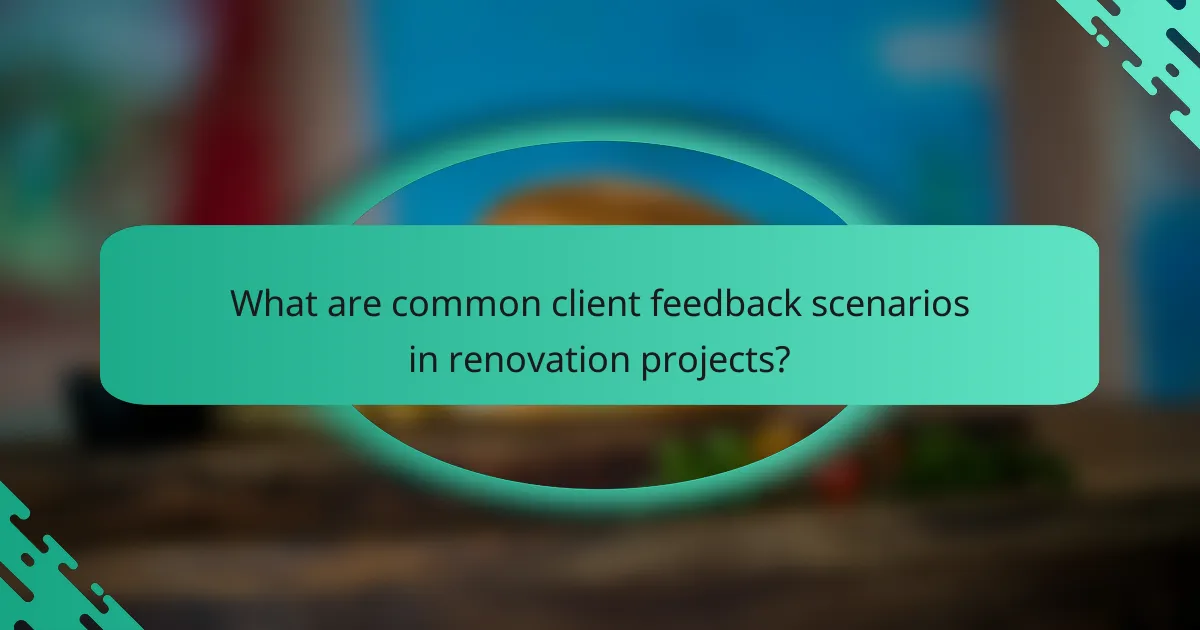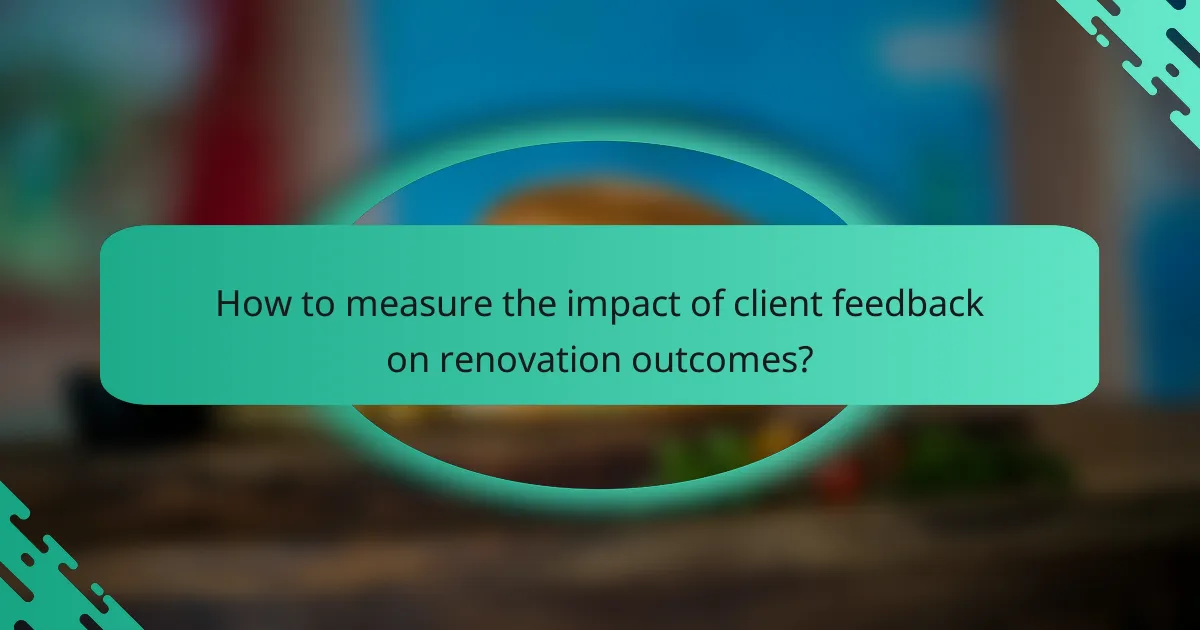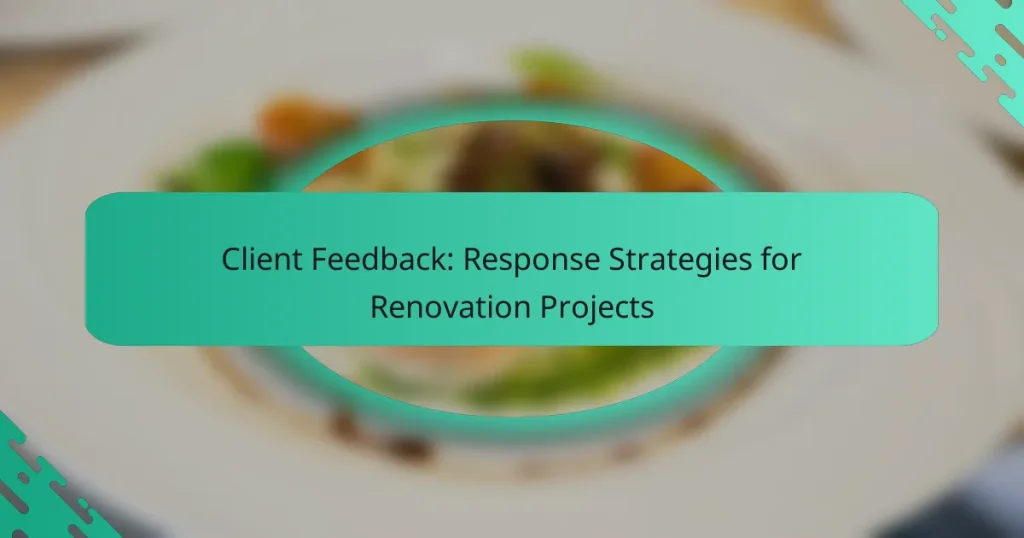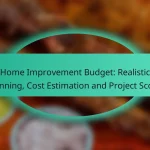In renovation projects, effectively managing client feedback is crucial for ensuring satisfaction and successful outcomes. By actively listening to concerns and communicating promptly, contractors can address requests for design changes, budget adjustments, and timeline modifications. Leveraging specialized tools can further enhance this process, allowing teams to streamline communication and gather valuable insights.

How to effectively respond to client feedback in renovation projects?
Effectively responding to client feedback in renovation projects involves actively listening to their concerns, communicating promptly, and following up in a personalized manner. This approach ensures clients feel valued and understood, leading to improved satisfaction and project outcomes.
Active listening techniques
Active listening is crucial in understanding client feedback. Techniques include maintaining eye contact, nodding to show engagement, and paraphrasing their concerns to confirm understanding. This not only demonstrates that you value their input but also helps clarify any misunderstandings early in the process.
Consider using open-ended questions to encourage clients to elaborate on their feedback. For example, asking “What specific aspects of the design do you like or dislike?” can yield more detailed insights than yes-or-no questions.
Timely communication strategies
Timely communication is essential for addressing client feedback effectively. Aim to respond to client inquiries within a day or two, especially after receiving feedback. This shows that you prioritize their opinions and are committed to making necessary adjustments.
Utilize various communication channels, such as emails, phone calls, or project management tools, to keep clients informed. Regular updates on how their feedback is being implemented can enhance trust and transparency throughout the renovation process.
Personalized follow-up methods
Personalized follow-up methods can significantly enhance client relationships. After addressing feedback, reach out to clients to discuss the changes made and gather their thoughts on the adjustments. This can be done through a phone call or a personalized email, reinforcing that their opinions matter.
Consider scheduling a brief meeting or site visit to review the project progress together. This not only allows for real-time feedback but also demonstrates your commitment to their satisfaction and the quality of the renovation work.

What are common client feedback scenarios in renovation projects?
Common client feedback scenarios in renovation projects include requests for design changes, concerns about budget, and adjustments to the project timeline. Understanding these scenarios helps contractors effectively address client needs and maintain satisfaction throughout the renovation process.
Design changes requests
Clients often request design changes during renovation projects to better align with their vision or preferences. These requests can arise from new inspirations, changes in lifestyle, or dissatisfaction with initial designs.
When handling design change requests, it is crucial to assess the feasibility of the changes and their impact on the overall project. Consider factors such as material availability, labor costs, and potential delays. Clear communication about the implications of these changes can help manage client expectations.
Budget concerns
Budget concerns frequently surface as clients navigate renovation projects. Clients may worry about unexpected expenses or whether the project will stay within the agreed financial limits.
To address budget concerns, maintain transparency about costs and potential overruns. Provide clients with a detailed breakdown of expenses and offer options for cost-saving measures. Regular updates on budget status can also help alleviate anxiety and build trust.
Timeline adjustments
Clients may request adjustments to the project timeline due to various reasons, such as personal schedules or unforeseen complications. These adjustments can affect project flow and completion dates.
When discussing timeline adjustments, be clear about the reasons for any delays and the potential impact on the overall project. Offer realistic alternatives and keep clients informed about progress. Establishing a contingency plan can also help manage expectations and ensure smoother transitions.

What tools can enhance client feedback management?
Effective client feedback management can be significantly improved using specialized tools that streamline communication and data collection. Utilizing the right software can help renovation project teams gather insights, track responses, and enhance overall client satisfaction.
Project management software like Trello
Project management software such as Trello allows teams to organize tasks visually and track project progress in real-time. By creating boards for different stages of the renovation, clients can easily see updates, provide feedback, and communicate their preferences directly on the platform.
Consider setting up dedicated cards for client feedback, where they can add comments or attach files. This keeps all relevant information in one place, making it easier to address concerns promptly and efficiently.
Feedback platforms such as SurveyMonkey
Feedback platforms like SurveyMonkey enable teams to create customized surveys that can be sent to clients at various stages of the renovation process. These surveys can gather specific insights on client satisfaction, preferences, and areas for improvement.
When designing surveys, keep questions concise and focused. Aim for a mix of multiple-choice and open-ended questions to capture both quantitative and qualitative feedback. Sending surveys after key milestones can provide timely insights that inform ongoing project adjustments.
Communication tools like Slack
Communication tools such as Slack facilitate real-time conversations between renovation teams and clients, enhancing responsiveness and clarity. Channels can be created for specific projects, allowing for organized discussions and quick updates.
Encourage clients to use Slack for immediate feedback or questions, which can be addressed swiftly. This reduces delays and fosters a collaborative atmosphere, ensuring that client concerns are heard and acted upon without unnecessary lag.

What are best practices for incorporating client feedback?
Incorporating client feedback effectively involves establishing clear communication channels and actively engaging clients throughout the renovation process. This ensures their preferences and concerns are addressed promptly, leading to higher satisfaction and better project outcomes.
Regular check-ins during the project
Conducting regular check-ins with clients is crucial for gathering ongoing feedback. Schedule these meetings weekly or bi-weekly to discuss progress, address any concerns, and adjust plans as needed. This proactive approach helps prevent misunderstandings and keeps the project aligned with client expectations.
During check-ins, use visual aids like progress photos or project timelines to facilitate discussion. Encourage clients to express their thoughts and suggestions, ensuring they feel valued and heard throughout the renovation process.
Feedback integration in project milestones
Integrating client feedback at key project milestones is essential for maintaining alignment with their vision. Establish specific points in the project timeline where client input is solicited, such as after design approvals or major construction phases. This allows for timely adjustments and enhances overall satisfaction.
Consider creating a simple checklist of milestones where feedback is required, such as initial design concepts, material selections, and final walkthroughs. This structured approach helps ensure that client preferences are consistently incorporated, reducing the likelihood of costly changes later in the project.

How to measure the impact of client feedback on renovation outcomes?
Measuring the impact of client feedback on renovation outcomes involves assessing how client input influences project satisfaction and success. This can be achieved through structured surveys and evaluating specific project metrics that reflect client expectations and experiences.
Client satisfaction surveys
Client satisfaction surveys are essential tools for gathering feedback on renovation projects. These surveys typically include questions about the quality of work, communication, and overall experience, allowing clients to express their opinions and concerns.
To maximize effectiveness, consider using a mix of quantitative and qualitative questions. For example, ask clients to rate their satisfaction on a scale from 1 to 10, followed by open-ended questions for detailed feedback. Aim for a response rate of at least 30-50% to ensure the data is representative.
Project success metrics
Project success metrics provide measurable indicators of how well a renovation project meets client expectations. Common metrics include adherence to budget, timeline, and quality standards, which can be tracked throughout the project lifecycle.
For instance, if a project is completed within 10% of the budget and on schedule, it can be deemed successful. Additionally, tracking the number of client revisions or complaints can help identify areas for improvement. Regularly review these metrics to adjust strategies and enhance future projects.

What are the challenges in managing client feedback?
Managing client feedback in renovation projects can be complex due to varying expectations, communication gaps, and emotional investment. These challenges can lead to misunderstandings and dissatisfaction if not addressed effectively.
Understanding client expectations
Clear understanding of client expectations is crucial for successful renovation projects. Clients may have specific visions or standards based on their previous experiences or industry trends. Regular discussions and visual aids, such as mood boards or 3D models, can help align expectations with project realities.
It’s beneficial to document these expectations in a formal agreement to avoid disputes later. This documentation can serve as a reference point throughout the project, ensuring that both parties remain aligned on goals and deliverables.
Effective communication strategies
Effective communication is essential for managing client feedback. Regular updates through emails, phone calls, or project management tools can keep clients informed about progress and any potential issues. Establishing a routine for check-ins, such as weekly meetings, can foster transparency and trust.
Listening actively to client concerns and responding promptly can mitigate misunderstandings. Consider using visual progress reports or timelines to illustrate project status, which can help clients feel more engaged and informed.
Handling negative feedback
Negative feedback is a common challenge in renovation projects and should be addressed promptly and professionally. Acknowledge the client’s concerns without becoming defensive, and seek to understand the root of the issue. This approach can turn a negative experience into an opportunity for improvement.
When addressing negative feedback, provide clear solutions or alternatives. For example, if a design element does not meet client expectations, offer adjustments or compromises that align with their vision while maintaining project feasibility.
Maintaining project timelines
Timely responses to client feedback are critical for keeping renovation projects on schedule. Delays in addressing concerns can lead to project overruns and increased costs. Establishing a clear timeline for feedback and revisions can help manage expectations and keep the project on track.
Consider using a structured feedback form that clients can fill out at designated stages of the project. This can streamline the process and ensure that all feedback is collected and addressed systematically, minimizing disruptions to the overall timeline.


